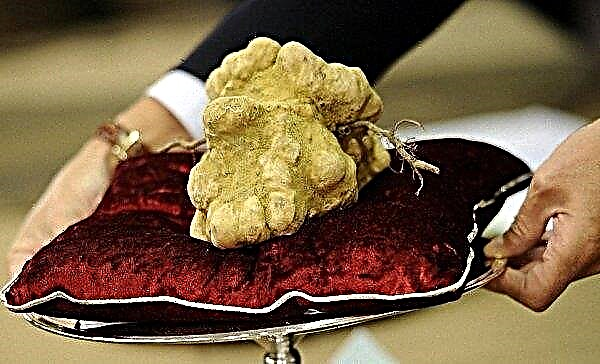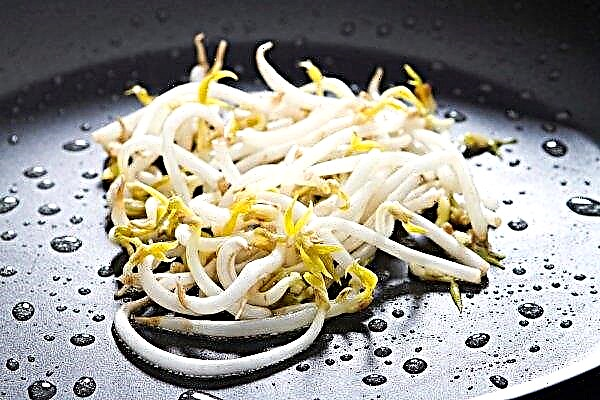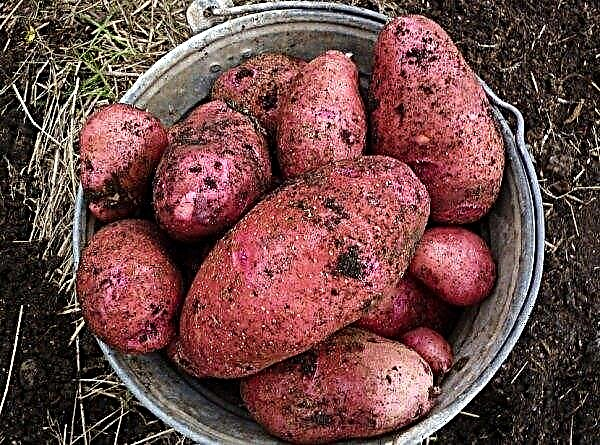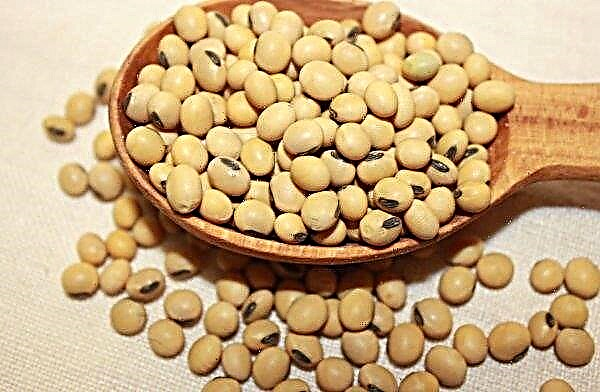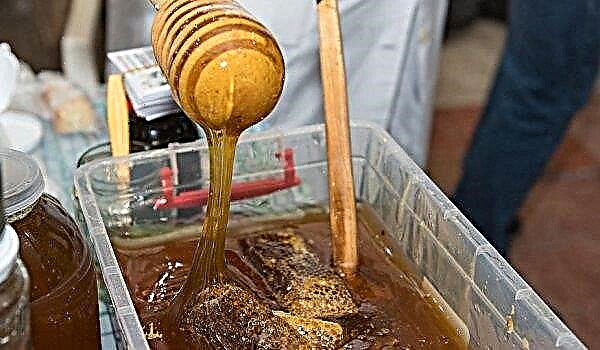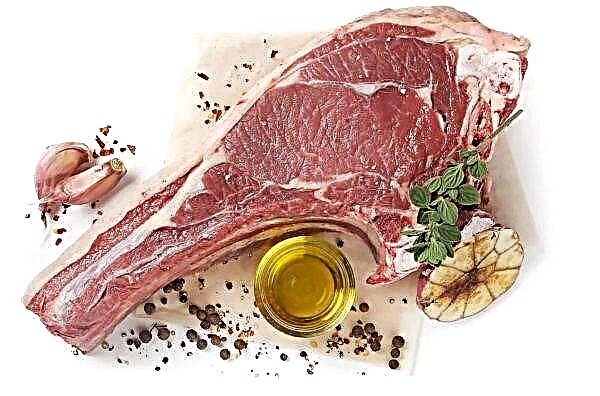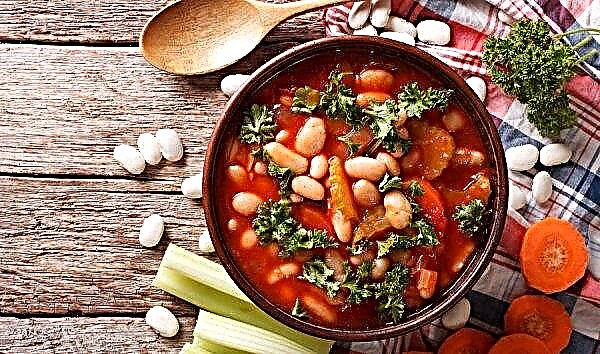The meat and egg breed of maran chickens has a lot of advantages and excellent performance indicators. They have many beautiful colors and unique features of eggs. For all its merits, maranas are unpretentious, but proper care for them should be provided.
The origin and history of the breed
The breed originates in 1895 thanks to the work of French scientists in the city of Maran. This area is characterized by a harsh climate, for which the view was deduced, so modern marans tolerate bad weather conditions and quickly became popular not only in their native country, but throughout Europe.
In Russia, the tendency to breed these birds is only gaining popularity.
Did you know? Marans are called chickens that carry golden or easter eggs. This is one of the pedigree signs - the eggs are bright brown, as if painted, and very large.
For breeding the breed in 1914, its creators received a gold award at the La Rochelle exhibition. This was the impetus for its rapid spread throughout the world outside France.
Description and characteristic
For an experienced poultry breeder, it’s easy to distinguish maran from any other breed of chicken. The first thing that catches your eye is an important, proud walk. The appearance of these birds is spectacular, catchy and sparkles with bright colors under the sun. Eggs and maran meat are considered one of the most delicious.
Representatives of the breed have the same characteristics, differing only in the color of plumage:
- copper black - the most common, the cock has a black chestnut with red specks, a black-copper shade of the neck and back, and the tail is blue-black; the female has completely black plumage, paler than the male, only spots of a redhead on her chest and a red necklace;
- wheat - the male has black chest, golden head, feather contour brownish-red with black tail feathers; the chicken has a reddish-golden color with a light brown head and neck, and a wheat breast;
- hawkish (cuckoo) - a golden cuckoo with bright plumage in females and silver with brighter drawings in roosters;
- black-tailed - red feathers, low tide golden, with a black tail in small brown spots;
- black - monotonous black color of the pen without interspersed with other shades;
- white - similar to black;
- black and silver - similar to copper-black, but with silver-black feathers;
- Colombian - white feathered with a black necklace;
- copper blue - light blue body color, copper head and neck.
There is also a subspecies of dwarf maranas, the only difference of which is the size of individuals and their eggs.
Appearance
Distinctive features of the breed:
| Appearance | Description |
| Plumage | Snug against the body |
| Head | Small |
| Crest | Red, 6 teeth |
| Earrings | Reds |
| Eyes | Red orange |
| Beak | Yellow, slightly curved |
| Neck | Down collar in males |
| Back | Wide, long, slightly concave to the tail |
| Housing | Elongated shape |
| Chest | Massive |
| Stomach | Pulled up |
| Wings | Powerful, developed, fit to the body |
| Tail | Short hanging |
| Paws | Strong, light shades, without strong plumage |
Productive qualities
Temperament
Maranas are active birds, very mobile, so they need a free range or a large space in the house. The nature of the chickens is balanced, flexible, do not conflict with other chickens and animals. Between themselves, they may conflict over food, make sure that it is enough. They do no harm to each other - usually the main cock intervenes and disperses the females.
Between themselves, they may conflict over food, make sure that it is enough. They do no harm to each other - usually the main cock intervenes and disperses the females.
Did you know? In France, maranas are called reigning birds. They received such an appreciation for the impression they make with their appearance, magnificent walk, proud posture, like peacocks.
Roosters can be quick-tempered, especially black ones. Marano males can be aggressive towards their owners if they don’t like something in their actions.
Advantages and disadvantages
- Advantages of Maran:
- the highest quality of meat and eggs;
- excellent endurance in bad weather conditions;
- stable immunity;
- good carcass weight;
- special conditions in the content are not needed;
- can be bred independently.
- Cons of the breed:
- help is needed when hatching chickens - the shell is very strong, you will need to be on guard at the eggs;
- need a lot of space.
Content Features
Among other conditions for keeping marans, the most responsible way is to treat the peculiarities of keeping these chickens in the winter. The room temperature fluctuates between 15-25 degrees, it is critical if it drops to a mark below 10. Therefore, before the cold weather starts, warm the foundation, floor, prepare heaters if there is no heating in the house.
Therefore, before the cold weather starts, warm the foundation, floor, prepare heaters if there is no heating in the house.
It is good to keep chickens in the winter in a special polycarbonate greenhouse - it also protects from blowing in the crevice and from predators. Another plus is transparent polycarbonate, birds will receive natural light.
Even in winter time, the livestock needs an influx of fresh air, but do not allow draft or hypothermia of the room. To extend the daylight hours, lamps are used - artificial lighting in winter should be 14 hours a day.
It will also be useful for you to find out that the meat breeds of chickens are referred to as faverol, and the egg - ameraukana.
Suitable conditions
The contents of the maranas are not considered whimsical and resistant to disease, although this does not mean that they do not need to be vaccinated.
To create favorable conditions for livestock, certain requirements must be observed:
- well-maintained chicken coop;
- patio for walks;
- high-quality diet and clean water;
- perches and nests.
If you want to neglect the needs of poultry and save on the maintenance of maranas, it is better not to start them at all - the loss from such savings will be much higher than the profit.
Chicken coop
The room under the chicken coop should be quite spacious, since the rams are mobile. The height from floor to ceiling is optimal 1.8 m. Be sure to have at least one window, chickens love light, and a window for ventilation is mandatory. The floor can be wooden or concrete, the flooring must be done. Sawdust, straw, hay, peat - only fresh and dry are suitable for him.
The floor can be wooden or concrete, the flooring must be done. Sawdust, straw, hay, peat - only fresh and dry are suitable for him.
Humidity is unacceptable in the chicken coop, otherwise the chickens will start to hurt. The inside should always be clean, the litter should be changed in a timely manner, avoiding the accumulation of moisture. Provide a good ventilation system or regularly ventilate the house.
A comfortable temperature for the bird is at least 15 degrees. Lightly affects egg production - individuals should receive it at least 10 hours a day.
It is important for layers to build nests, given the requirements:
- 1 nest for 5 hens;
- location height - 35 cm from the floor;
- nest entrance 25x25 cm;
- width and depth 30 cm;
- bedding made of dry, clean hay;
- there must be a ladder with a shelf to the entrance;
- the location of the nests is under the perches;
- the roof should be sloping so that the chickens do not sit on it and do not get dirty.
Perches are best placed opposite the window. The thickness of the poles must be at least 6 cm and the height 120 cm from the floor. So that the marans do not dirty each other, you can place perches with a ladder or along the perimeter of the chicken coop.
Walking yard
Hens of this breed need walks on the street. Both males and females are active, and fresh air with microelements obtained in the yard positively affects productivity. Build a spacious, fenced walking yard, where the bird can walk on its own all day. If you do not have a place for such a yard, the chicken coop should be very large and with the lights turned on 11 hours a day.
Build a spacious, fenced walking yard, where the bird can walk on its own all day. If you do not have a place for such a yard, the chicken coop should be very large and with the lights turned on 11 hours a day.
Feeding troughs and drinking bowls
The maran feeder should not be too wide so that the chickens do not climb in there whole, scattering food. It is convenient if they are long and suspended from the wall. Calculate the number and length of the feeders so that all herds can eat at the same time. There should not be any sharp edges, decorative elements.
Important! Monthly feeders and drinking bowls need to be washed and disinfected with chlorhexidine or hydrogen peroxide.
The ideal drinking bowl is closed. So marans will not be able to splash in it and spray water around. It will stay clean longer, and excess moisture will not appear in the chicken coop. Drinking bowls are also suspended so that the bird does not trample on them and does not turn over.
Feeding
The diet of maranas chickens should be balanced and full at all times. Make sure that the layers do not overeat - this will reduce egg production. Per chicken accounts for about 75 g of feed per day. Feed the bird twice a day.
You can buy or mix feed yourself:
- corn - 45%;
- wheat grain - 12%;
- peas - 8%;
- sunflower meal - 7%;
- barley - 7%;
- crushed chalk, small shells - 7%;
- meat and bone, fish, grass meal, fodder yeast - 5%;
- salt - 0.3%.
 Fresh chopped greens, boiled vegetables (potatoes, beets, carrots, rutabaga, a little cabbage) are added to the feed. This top dressing should be delivered to a laying hen 3-4 times a day: twice with feeding and twice separately. Greens are responsible for the brightness of the yolk in the egg.
Fresh chopped greens, boiled vegetables (potatoes, beets, carrots, rutabaga, a little cabbage) are added to the feed. This top dressing should be delivered to a laying hen 3-4 times a day: twice with feeding and twice separately. Greens are responsible for the brightness of the yolk in the egg.Important! Do not feed the maranas with fresh bread; it is harmful to them. It is better to replace it with crackers soaked in water, adding sprouted crops.
For assimilation and better grinding of food, maranas should have separate bowls with coarse-grained sand and small pebbles.
Shedding and egg laying break
Seasonal molting occurs in marans at the age of two years and is repeated once a year. It usually falls in late autumn, October – November. Duration of molting from 6 to 8 weeks. This is a natural process associated with shortening the day and may begin due to stress.
During molting, laying hens cease to lay eggs. Egg production is restored in January. When chickens change their plumage, it is necessary to increase the amount of food and add clover, alfalfa, meat and bone meal, cabbage, peas containing sulfur to the diet. Grain, on the contrary, is removed from the menu.
Germinated grains are included in the diet when new feathers begin to grow.
Herd replacement planned
Life expectancy of maranas is 5–7 years. The highest productivity occurs in the first 2–3 years of the life cycle. Further egg production begins to decline, in the end, the laying hen ceases to lay eggs at all. Therefore, with a decrease in productivity, they are put on meat and plan to replace the herd.
How to breed chickens?
Marani females have a strong instinct for incubation, so you can engage in breeding chickens on their own, naturally, or in an incubation version. An important point is that closer to the date of hatching of the chicks you should be there all the time, you will have to distribute your schedule taking into account this nuance.
Reproduction of offspring
For incubation, you should choose large eggs weighing 65 g with the maximum dark shell. Thus, the probability of maintaining the best genetic qualities of the breed increases. Ideally, if these are eggs from chicken with an excellent exterior in the standard. To prevent the embryos from drying out, the eggs in the incubator must be rotated periodically, 4–8 times a day.
No need to turn over from the 19th day.
Observe the humidity regime - once a day you need to spray eggs with water from a spray bottle. The first 7 days, the humidity in the incubator should be 55–60%, the next 7–50%, from 15 to 18 — 45%, then - 70–75%.
Overheating of the embryos is fraught not only with their death, the chicks can survive, but they will be born with defects - crooked fingers. Therefore, from the 16th day in the incubator, lower the temperature by about 0.2 degrees every day.
The temperature in the incubator:
- 1-16 days - 38 ° C;
- 17-21 days - 37.8-36.8 ° C.
In the period from the 15th to the 18th day, you need to ventilate the incubator for 10-15 minutes twice a day. With proper incubation, the chickens of maran are born on the 21st day. On the day of the alleged bite, you need to look after the eggs - their shell is extremely strong, not all chicks can break it on their own. If they are not helped, they will perish.
With proper incubation, the chickens of maran are born on the 21st day. On the day of the alleged bite, you need to look after the eggs - their shell is extremely strong, not all chicks can break it on their own. If they are not helped, they will perish.
Feeding
To maintain a nutritional balance of chickens, there is a scheme:
- 1-3 day - cottage cheese every 2 hours with chopped boiled eggs;
- 4-6th day - chopped boiled eggs with chopped millet or corn grits;
- 7–9th day - feeding 5–6 times, a shell rock or grated shell is introduced;
- 10–13th day - feeding 4 times;
- from the 14th day - plant food (carrot, clover, nettle) is introduced.
Food should be exceptionally fresh.
Baby Care
The first week of marani chickens is kept in a box with a towel and in the house while maintaining a 30 degree temperature regime. Decrease - every day by 2 degrees.
From the 8th day you can let the chicks go for a walk, but the limit is 3 hours and without adults. Young animals of this breed are hardy, but they can be moved to the barn no earlier than in 30 days. Careful supervision - up to 3 months.
From a month it is important:
- give diluted manganese with water twice a week;
- include coarse sand in the menu;
- add the grated beets.
Full adult diet from 3 months.
Disease and treatment
The most common diseases for maran:
- abdominal dropsy due to malfunctioning of the kidneys - the chicken is sluggish, the stomach is enlarged; treatment - to pierce the abdomen with a syringe, pump out excess fluid, give diuretics;
- poo-eaters - external parasites, which are easy to detect under the wings of a bird and in the area of the cloaca, for prevention and treatment should be large baths of ash and sand in a ratio of 1: 1, infected feathers and fluff need to be burned;
- scabies - it is quickly transmitted from individual to individual, it is necessary to treat it urgently - dilute the soap in warm water and keep the paws of the sick chicken in it for half an hour, then carefully lubricate with creolin;
- ascariasis - internal parasites, medication (Phenothiazine, Piperazin, Hydromycin), the drug is mixed with food according to the instructions, the chicken coop is cleaned and disinfected with alkali, xylonaphtha solution or fluorochlorophenol.
To prevent chickens from contracting serious viral diseases, do not forget to vaccinate them. Marana breed is the choice for those who want to have a good profit, without having to deal with the cultivation of overly demanding birds. But farming is hard work, which should be prepared for.
Marana breed is the choice for those who want to have a good profit, without having to deal with the cultivation of overly demanding birds. But farming is hard work, which should be prepared for.


